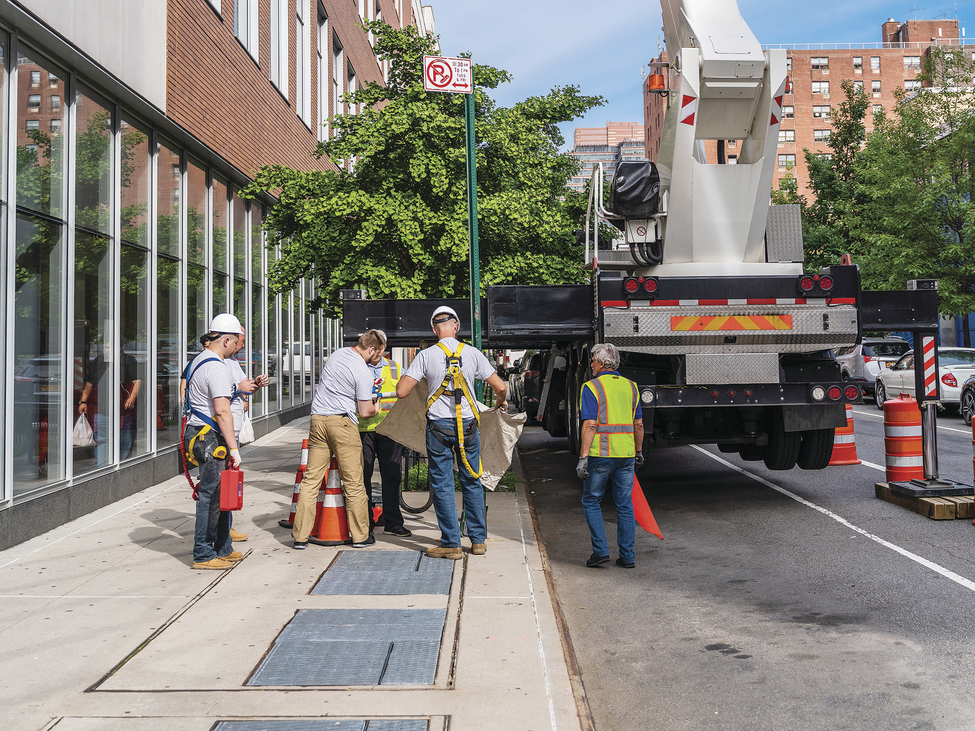Investment Trends and Challenges for Public Entity Risk Professionals

A Travelers Special Report
Public entity leaders have long played an important role in fostering community growth in the face of economic headwinds. New Travelers research reveals how these individuals are adapting to rising pressures of inflation and economic uncertainty. Despite these challenges, key decision-makers in municipalities and counties are making significant investments in their communities and the people who serve them. Noteworthy among them are investments in infrastructure development and maintenance, mental health support services for employees and first responders, and revitalization of existing projects.
Travelers conducted a proprietary survey of public entity employees who have risk management decision-making responsibilities to understand where – and how – municipalities and counties prioritize their investments and the factors driving their decisions. Travelers shares these responses along with deeper insights into how public entities deal with pressing issues like inflation, environmental risks, shifting social attitudes and more.
One observation stands out: While the responsibilities and challenges public entities face seem more complex than ever, many survey respondents demonstrate resilience and adaptability that defies the pressure. They recognize the importance of their role in helping their communities continue to grow and thrive.
"At Travelers, we understand the unique challenges public entities are facing in this current climate. That’s why we’ll continue to support them, so they can focus on what matters most: supporting their communities.”
Diane Barr
Vice President and National Practice Leader, Public Sector Services, Travelers
The top investment priorities for public entities
Where public entities invest provides a glimpse into how they plan to support continued growth of resilient, prosperous communities. Our research reveals the most common types of investments public entities are making, including which are considered top priorities.

Investments
| Current investment | Top investment | |
|---|---|---|
| Economic development* | 43% | 13% |
| Public safety* | 40% | 12% |
| Infrastructure maintenance* | 38% | 7% |
| Education* | 38% | 10% |
| Infrastructure development | 34% | 10% |
| Healthcare services | 34% | 9% |
| Social services | 33% | 4% |
| Technology and innovation | 33% | 6% |
| Workforce development/upskilling talent | 29% | 6% |
| Support services for employees | 27% | 5% |
| Housing | 26% | 5% |
| Emergency management | 24% | 3% |
| Parks and recreation | 23% | 3% |
| Community events/activities | 22% | 2% |
| Transportation/vehicles | 21% | 3% |
| Solar/renewable energy | 21% | 3% |
| Increased staff | 21% | 2% |
| Cultural and arts programs | 19% | 2% |
*Most common investments
Economic development
Economic development is more than just an investment – it’s a commitment to a thriving community. With 43% of surveyed risk professionals currently prioritizing economic development – and 13% indicating it’s their top investment focus – the trend suggests that municipalities and counties are actively focused on creating opportunities for local businesses, fostering entrepreneurship and ensuring long-term growth.
Public safety
Survey results underscore the critical role public safety plays in building stronger, more resilient communities and ensuring the well-being of residents. Notably, 40% of respondents say they currently invest in public safety, with 12% saying it’s a top investment. Examples of these investments include deepening training programs for emergency responders, keeping local parks and playgrounds up to ADA codes and spreading community awareness of emergency response plans.
Infrastructure
Up to 38% of municipalities and counties report a focus on infrastructure development and/or maintenance. Roads and highways (47%), water supply systems (46%) and public transit systems (45%) were the top areas of investment, followed closely by building construction – including additions (44%), sewage and wastewater treatment plants (42%) and telecommunications infrastructure (41%).
Areas of investment: Infrastructure
Among municipalities/counties that invest in infrastructure development and/or maintenance

| Roads and highways | 47% |
| Water supply systems | 46% |
| Public transit systems | 45% |
| Building construction (including additions) | 44% |
| Sewage and wastewater treatment plants | 42% |
| Telecommunications infrastructure | 41% |
| Recreational infrastructure construction | 40% |
| Restoration/maintenance of historic building | 40% |
| Electrical grids and transmission lines | 37% |
| Bridges and tunnels | 26% |
| Railways and subways | 25% |
| Flood control/dams/levees | 25% |
| Power plants | 22% |
| Ports and harbors | 21% |
| Airports | 13% |
Emerging investment trends
Public entities tailor their investments to their communities’ needs. However, it’s worth noting that consistent themes within the public sector tend to emerge, largely based on macro forces. Our survey revealed that more public entities than ever are concerned with economic issues (including inflation) and are adapting how they prioritize projects to accommodate higher expenses.

Revitalization: Everything old is new again
Looking ahead, municipalities and counties plan to spend slightly more to revitalize existing projects (53%) than to develop new ones. Revitalization often balances the desire to improve quality of life within a community with the need to manage a potentially limited budget.
Shifting attitudes may influence where investments are being made
With 42% of respondents indicating that they’re more worried about inflation than they were the prior year, this trend of communities grappling with rising costs of goods and services is strengthening. Concerns over economic uncertainty (40%) and environmental risks such as pollution (39%) have also increased over a 12-month period, followed closely by:
- Energy costs (37%)
- Unhoused and/or immigration issues (36%)
- Public attitudes toward government (34%)
- Cyber threats (33%)
Legal liability, availability of products and services for repair, and transportation and auto fleet challenges remain persistent worries, with about half of respondents reporting that their level of concern over these issues remains unchanged.
Some communities indicate that they’re less worried about law enforcement as an emerging risk than they were 12 months ago (28%), while others say their concern level within that same time period is the same (42%).
Survey data also reveals that dedicated risk managers have slightly different areas of focus, with social unrest (44%), unhoused and/or immigration issues (41%) and public attitudes toward government (41%) worrying them more than they did last year.

Trend spotlight: The growing importance of workforce well-being
Recognizing that a well-supported workforce is a safer and more effective workforce, public entities proactively make investments in mental health, employee assistance programs and wellness initiatives.
Mental health support continues to expand for law enforcement and first responders
First responders, including law enforcement officers, firefighters and paramedics, are often exposed to high-stress and high-risk situations. Enabling first responders’ access to mental health resources is an important responsibility of a public entity. To respond to this growing need, 83% of municipalities and counties are investing in mental health programs. These initiatives are designed to help first responders and law enforcement teams learn how to recognize signs of stress and PTSD, avoid burnout and get access to therapy and peer support programs.
“Public entities are on the front line of seeing how economic and social forces impact their communities and employees, and they want to help by investing in people and the programs that serve them. By continuing to invest in mental health services – despite potentially shrinking budgets – public entities are showing that the well-being of public servants will always be a top priority.”
Diane Barr
Vice President and National Practice Leader, Public Sector Services, Travelers

Public entities are increasing holistic support for employees
Over a quarter (27%) of municipalities and counties invest in support services for employees, primarily through:
- Employee assistance programs (91%)
- Health and wellness programs, such as fitness classes, health screenings, etc. (69%)
- Recognition and reward programs (65%)
Of these respondents, 5% consider it a top investment within their community, marking an increased awareness of the positive impact these wellness programs can have on employee well-being, productivity and retention.
How municipalities and counties are promoting good mental health
Counseling/therapy services
-
- “Providing access to licensed therapists and counselors specializing in the trauma and stress experienced by first responders.”
Training and education
-
- “Regular mental health training and education help officers recognize signs of stress, burnout, PTSD or other mental health issues.”
Peer support and support groups
-
- “Through the establishment of peer support groups, law enforcement officers and first responders are encouraged to support each other, share emotional distress and understand each other.”
Paid time off and leave policies
-
- “Mental health leave is provided to these staff.”
Insurance and financial support
-
- “We believe in offering great insurance that includes mental health services.”
Economic headwinds: Investment risks and challenges facing public entities
Public sector leaders are committed to investing in their communities despite the challenges of the financial environment. While inflation, funding constraints and evolving economic pressures are top concerns, our research shows that municipalities and counties continue to find innovative ways to effectively serve their communities.
Inflation increases risk exposure for public entities
With nearly all public entities (98%) reporting inflation as a key factor influencing their investment decisions, local governments are feeling the pressure to carefully balance community investments with fiscal responsibility. While costs are rising in key areas, proactive planning and cost-saving strategies can help minimize inflation’s effects.
Impact of inflation on public sector investments
- Technology investments (33%) – Many public entities adjust their technology plans to ensure cost-effective solutions while still modernizing infrastructure. Prioritizing digital transformation in phases and leveraging cloud-based services can help maximize budgets.
- Service contracts (31%) – Municipalities and counties explore long-term contracts and cooperative purchasing agreements to stabilize costs and ensure consistent service quality.
- Materials and supplies (31%) – Inflation affects the cost of materials for public works and construction, so public entities adopt sustainable sourcing and bulk purchasing strategies to mitigate price fluctuations.

Uncertainty around federal funding
While surveyed public entities report receiving most of their funding from their state government (81%), half of respondents also report receiving federal funding (50%). This reliance on federal funding could introduce a layer of complexity and uncertainty for municipalities and counties, as the unpredictability of federal budget allocations could cause projects to be de-prioritized or abandoned altogether.
This uncertainty around federal funding can complicate long-term planning and investment strategies. For example, public entities may take a more cautious approach to investing in new initiatives and projects, potentially slowing down innovation and progress. As a result, communities could end up experiencing delays on projects that may provide critical resources and support to residents.
“Public entities are understandably concerned about the loss of potential funding. Community leaders that adopt a forward-thinking approach, focus on long-range planning and facilitate productive connections with their elected officials will be in the best position to weather challenging economic conditions.”
Amy Schmidt
Chief Underwriting Officer, Public Sector Services, Travelers
Protect the investment that matters most: Your community
There’s no denying that public entities have embraced a spirit of adaptability and creativity to meet many of the economic, social and financial challenges highlighted in this report. Reprioritization of projects, increased investment in mental health support for employees and focus on long-range, comprehensive planning are just a few of the ways public entities are continuing to meet the needs of their communities while also addressing economic headwinds.
At Travelers, we’re dedicated to supporting public entities with specialized insurance solutions and tailored risk mitigation strategies. As organizations assess their total cost of risk amid potential budget cuts, reducing costly exposures and protecting crucial investments can help secure a positive future for their communities.
For more information, contact your independent Travelers insurance agent.
Source
Travelers Public Sector Survey, 2025

Top stories
How Counties and Municipalities Can Reduce Their Total Cost of Risk
Learn practical ways to identify, manage and control risks and losses for public entities with Travelers.
Related products & services
Public entities
We specialize in public entity business and maintain industry-specific expertise to help remove the uncertainty of risk unique to public entities.
More Prepare & Prevent
Resources for Technology
Managing Video and Social Media Policies for Law Enforcement Organizations
Videos and social media presents law enforcement with new risks. Here are five tips to help manage those risks.

Risk Insights for Public Entities
The Growing Threat of Ransomware Attacks on the Public Sector
Public sector ransomware attacks have risen sharply in recent years. Learn how to protect your data and minimize your risk of encountering a breach.

Resources for Technology
5 Ways Cities, Municipalities and Other Public Entities Use Smart Tech for Public Safety
Smart streetlights and predictive policing are two ways smart technology is used for public safety. Explore smart tech for public safety.
